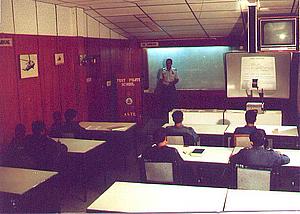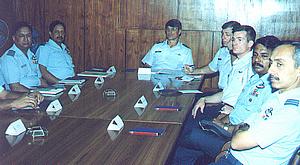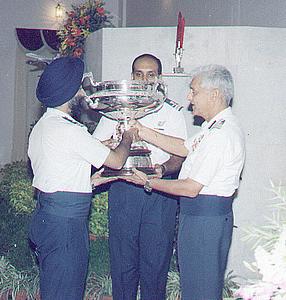
ASTE’s fleet in December 1997 includes: 2 An-32s, HS748 ASWAC, MiG-21US, MiG-21Bis, Jaguar IS, Jaguar IM, MiG-27, HJT-16 Kirans, Chetaks, Mi-8 and a HPT-32. These aircraft help the pilots of the AFTPS to hone their flying skills across all types of aircraft.
Aircraft & Systems Testing Establishment (ASTE) is unique in Asia. As its name implies, ASTE evaluates aircraft and systems for induction into user organisations. Most new aircraft types and major airborne systems must have ASTE’s stamp of approval to be considered fit for service in India. While many countries have testing facilities of one kind or the other, training of flight test personnel is not often imparted in them. ASTE’s Air Force Test Pilots School (AFTPS) is only the fifth such institution in the world. This is not surprising for the world’s fourth largest air force. The combination of flight testing and training makes ASTE Indian Air Force’s mini-Edward’s Air Force Base (USA) or Boscombe Down (UK). And, it is just as professional.
Genesis.
There was no requirement for specialised flight testing in the Indian Air Force (IAF) in its early years from its origins in 1932. The need to raise a testing unit came up with the purchase of the Folland Gnat Mk I. In April 1957, this became the Aircraft & Armament Testing Unit (A&ATU) and was stationed at Kanpur in Uttar Pradesh.
Training of Indian test pilots began with two pupils attending the Empire Test Pilots School (ETPS) in the UK in 1949. Thereafter a trickle of test pilot graduates followed. These were trained in UK, France and USA. Because of the very high cost of training, IAF never seemed to have enough of them.
In August 1972, A&ATU was upgraded to ASTE with the addition of the task of training flight test crew. The author who had by then commanded A&ATU for two years and eight months became ASTE’s first Commandant. According to military tradition the latter title is required for establishments where training is carried out. The first courses taught pilots the principles and techniques of production testing. They were designated as Flight Inspectors and later as Production Test Pilots. Since 1976, most experimental test pilots have been trained at ASTE. A few selected trainee pilots and engineers have still been sent abroad to learn prototype testing, mainly to update the nation’s knowledge.
Move to the aviation capital.
Bangalore is where all the aviation R&D activity is concentrated. Hindustan Aeronautics Limited (HAL), several Defence R&D Organisation’s (DRDO’s) aviation related establishments and National Aerospace Laboratory (a civilian entity) are all located in this “Garden City” with an air-conditioned climate. It was decided that ASTE should move to Bangalore to meet flight testing needs of all these organisations. The move to Bangalore was completed in June 1973. It is now housed just south of the HAL Airport’s main runway. Gradually, ASTE has acquired all the buildings, hangars and aprons that it needs to meet its tasks of flight evaluation and training. While telemetry has been in use for some time, a new building for it is now functional. Using its enhanced facilities, real-time display of each test flight enables a lot to be achieved in the shortest flight time. The cost of testing prototype aircraft and systems, and also training, has come down significantly.
Training of Flight Test Personnel.
In 1972 itself, soon after its upgradation, ASTE first started training pilots for production testing. Three years later, senior ASTE officers visited ETPS and studied its training methods. These were eventually used to start a course for experimental test flying in 1976. AFTPS is now a premier institution, which trains flight test crew to meet the requirements of the Indian Air Force, the other two services and some non-military organisations involved with aviation. The school is in close proximity of various aerospace research and development establishments as well as aircraft design and manufacturing facilities. This is of great help in showing trainees what they are expected to do. Test pilots and flight test engineers are trained by AFTPS to work as a cohesive flight test team. Since its inception, more than one hundred fixed wing pilots, twenty rotary wing pilots and forty flight test engineers have passed through the portals of this school. The school enjoys a good reputation among flight test training institutions abroad.
Training Philosophy.
The school runs 46-week long concurrent Flight Test Courses (FTC) for pilots, test engineers and instrumentation engineers. Though the courses are arduous, they are very rewarding because AFTPS exposes students to a field many don’t even know exists. By the end of the course, one easily appreciates the intricacies involved in designing as well as flight testing of an aircraft or a system. The formulation of a sound training philosophy has richly contributed to the production of competent flight test crew from the school. Emphasis is laid on working together as a flight test team. The essential ingredients of training are: –
* Foundation of engineering concepts.
* Precision and Safety in flying
* Specialisation in concerned areas of expertise in the respective streams.
In keeping with the latest trends in flight testing the world over, as well as the levels of sophistication of aircraft and systems, the AFTPS conducts training for: –
* Fixed Wing Test Pilots .
* Rotary Wing Test Pilots.
* Fixed Wing Flight Test Engineers.
* Rotary Wing Flight Test Engineers.
* Flight Test Engineers From the Avionics Stream.
* Flight Test Instrumentation Engineers.
The training imparted during the course is both practical as well as theoretical. Trained personnel can easily interact with both the operator and the designer. The courses include over 500 hours of lectures and 100 to 150 hours of flying on a wide variety of aircraft. AFTPS is unique in the world in being able to offer aircraft types both from the Western and Eastern Blocs. The school teaches flight test techniques on instrumented aircraft, which are carefully selected for each test exercise so as to bring out all the relevant flight testing aspects. In-flight data recording uses modern digital instrumentation. Students are required to fly even unfamiliar aircraft types as pilots in command. This is inescapable for single seater aircraft. Where a second pilot is needed, he does not have to be an instructor. The challenge is for the trainee to cope well with a new type of aircraft. Only the best pilots available are admitted to the course after a careful and stringent selection process. Different flight test exercises give an excellent opportunity to the students to assimilate flight test techniques and prepare them for their future assignments.
During the course, students are taken to the premier aeronautical industries and also R&D organisations within India on study tours. A visit to one or two leading flight test schools and several aeronautical industries abroad is also arranged. As a part of the curriculum, guest lectures are given by eminent personalities in the field of aviation research and development. These help students become aware of the latest trends in aviation. They get better prepared for when they would enter the world of flight testing.
Students are taken to various IAF Stations and are given exposure to many other in-service aircraft types. As a part of their training, they also fly and evaluate flight simulators of Boeing 737, Airbus 300, Airbus 320 and the Air Combat Simulator. They used to get to fly the variable stability aircraft during their study tour abroad. There are some indications that one or two of these aircraft have recently been retired. Student exchange programmes with other test flying training institutes have commenced in a limited way. AFTPS students evaluated the Black Hawk helicopter at the United States Naval Test Pilots School. US students did similar work on the Mi-8 at AFTPS. Till recently exchanges for fixed wing aircraft were held in abeyance due to US sanctions on India. Perhaps the school is now ready to welcome students for training from friendly countries, especially our neighbours and from the ASEAN nations. Due to political implications, the move towards the exchanges of pupils and directing staff needs to come from the Government of India.
| Visit to BAE Systems UK 22 FTC Mar 2000 |  |
 |
An instructor briefs a student pilot before his sortie at the AFTPS. The aircraft in the background is an Iskra trainer. |
The Preview.
Having learnt the various aspects of flight testing, students are given the ultimate opportunity – that of evaluating an aircraft which they have never flown before. To make this exercise realistic, the task directive includes a set of Operational Requirements (ORs), which are similar to ORs that would be raised for a real aircraft induction. The multiplicity of aircraft types in the Indian armed forces provides a wide variety of aircraft for evaluation. These represent front-line aircraft and helicopters from both, the Western world and the Russian aviation industry. Students thus have a unique chance to study, analyse and compare various design philosophies, an advantage not currently available to any other test flying training institution of the world. This also contributes to fostering global understanding of design philosophies. Engineers’ training culminates into a real-world project, which must be usable for in-service operation or flight testing. Each engineer’s project involves a detailed thesis, design, fabrication and flight testing of a working model. These provide a good opportunity for the student test engineer to put his ideas into practice. The school has immensely benefited from such projects, which are at times utilised for ASTE’s flight testing and also for training of future courses.
Suranjan Das Dinner.
After nearly a year of hard labour, successful students pass out at a formal dining-in-night. This is a tradition handed down by the ETPS (UK) where the McKenna Dinner is the graduation ceremony. The AFTPS’ dinner is named after the Late Group Captain Suranjan Das who was the chief test pilot of HAL (see Indian Aviation, January 4-10). The dinner is followed by the presentation of graduation certificates to the new test pilots and test engineers. The Suranjan Das Trophy donated by HAL is awarded to the pilot standing first on the course. Other special merit is also recognised by the award of trophies. Wives of graduating test pilots and engineers receive a scroll extolling their forbearance during the course.
Whatever the task, ASTE can be relied upon to meet it competently. It will surely live up to its Sanskrit motto. This translates as, “Precision and Excellence”. Its AFTPS not only adheres to the same goals but in fact develops the human resources to make them a reality.
This article first appeared in Indian Aviation Magazine. Reproduced with the permission of the Author.






